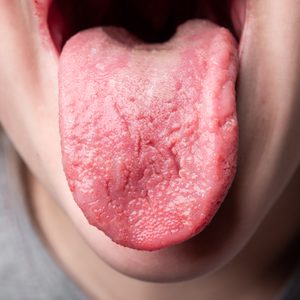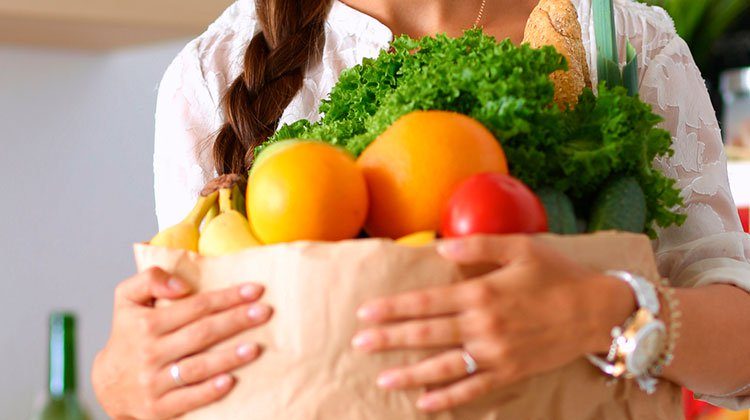
How long produce lasts—and how to keep it fresh for as long as possible
You’ve just arrived home from the farmers’ market or grocery store laden with bags full of plump blueberries, juicy peaches and bright leafy greens, ready to be made into fantastic meals. Keep your bounty fresh with our handy food storage guide.
We’ll outline the shelf life of common fruits and vegetables so you can smartly plan meals to eat your most fragile foods first. (No more finding slimy lettuce in the crisper drawer at the end of the week!) We’ll also share storage tips to help preserve your food longer and in its best condition. Finally, we share signs that your food is at peak ripeness so you can enjoy that fleeting summer peach or crispy winter cauliflower at its glory. Want more? Read up on our secret tricks to keep fruits and vegetables fresh longer.
| Produce | How Long It Lasts | Tips for Fresh Produce |
|---|---|---|
| Apples | 4-8 weeks in the fridge | It’s OK if your apple has a few brown spots. Those can be cut away. But if it looks wrinkled or feels mushy, it’s time to toss. |
| Avocado | 4-7 days at room temperature | Peel off the stem. If the skin underneath is green, the avocado is ripe. It’ll also give in to light pressure when squeezed. |
| Bananas | 2-5 days at room temperature | Bananas are best when they’re yellow and have just started to develop brown spots. A ripe banana will be easy to peel. |
| Blueberries | 1-2 weeks in the fridge | Most blueberries you get at the store will be ready to gobble down. They’ll have a blue-gray colour. If they start to feel moist or look mouldy, it’s time to toss. |
| Broccoli | 7-14 days in the fridge | Your broccoli should have a rich, green colour. It’s best to eat when the stems feel firm, not limp. |
| Carrots | 3-4 weeks in the fridge | Carrots are past their prime when they feel limp or have developed a white, grainy look. If you bought carrots with their greens on, it’s best to cut the greens off and store separately. |
| Cucumbers | 1 week in the fridge | Your cucumber should have a bright and even green colour throughout. Discard if it has any sunken areas, is yellow or has wrinkly skin. |
| Garlic | 3-6 months at room temperature | Garlic in its prime will feel firm and have an off-white colour. If it’s grown any sprouts, peel them away before cooking. Pass up garlic that has turned tan or looks wrinkly. |
| Iceberg and romaine lettuce | 7-10 days in the fridge | If your greens look discoloured, feel soggy or have a rotten smell, it’s time to discard. |
| Lemons | 3-4 weeks in the fridge | Healthy lemons will be bright yellow and slightly firm to the touch. It’s overripe if it has soft spots, dark blotches or is oozing juice. |
| Onions | 2-3 months at room temperature | A good onion will look clean and feel firm. Moisture and soft spots can be a sign it’s gone bad. |
| Oranges | 3-4 weeks in the fridge | Juicy oranges will look bright and feel slightly firm to the touch. Check to see that there are no soft spots. |
| Peaches | 1-3 days at room temperature | Ripe peaches will have a deep golden colour. They’ll also wrinkle slightly around the stem and give in a bit when gently squeezed. |
| Potatoes | 3-5 weeks in the pantry | A good potato will feel firm and smell like earth. It’s OK if it has small sprouts, but if the sprouts are longer than a few centimeters, your potato may have gone bad. |
| Strawberries | 3-7 days in the fridge | Fragrant and bright strawberries are the best to eat. Discard if there is any sign of mould. |
| String beans | 3-5 days in the fridge | The beans should be slender and firm without any visible seeds. You’ll know they’ve gone bad if they’ve turned limp or moist. |
| Tomatoes | 1 week at room temperature | Ready-to-eat tomatoes will feel firm when slightly squeezed and seem slightly heavy compared with their size. |
| Watermelon | 7 to 10 days at room temperature | Tap on the side. If the melon sounds hollow, it’s good to eat. Also, it should feel firm when pressed but not hard as a rock. |
| Whole mushrooms | 7-10 days in the fridge | If the mushroom feels sticky or slimy, it’s bad. Whole mushrooms will keep longer than sliced mushrooms. |
| Zucchini | 4-5 days in the fridge | Your summer squash should be firm yet slightly flexible and have glossy skin. If the zucchini looks gray, it may be overly ripe. |
No matter what-or when-you decide to cook, it’s best to err on the conservative side when judging whether food is safe. Trust your instincts. If something looks or smells off, your best bet is to toss (or compost).
Next, find out the foods you’re ruining by storing in the fridge.
One of the most irritating aspects of spending time outdoors in the summer is the pesky mosquito. But no matter how you try to avoid them, some people naturally attract mosquitoes more than others.
Your breath attracts mosquitoes
One of the most important facts to remember is that mosquitoes track people down by smell and body odour, according to Bart Knols, PhD, a vector biologist dedicated to the study of mosquitoes. The carbon dioxide people exhale, along with chemicals from the skin, create an “odour plume” that mosquitoes can detect from up to almost 30 metres (100 feet) away, Knols says. “Each person gives off more than 300 chemicals from the skin, more than 100 in exhaled breath,” Knols says.
Your smell attracts mosquitoes
The specific compounds on the skin that mosquitoes respond to vary by species. The yellow fever mosquito and Asian tiger mosquito, for example, respond well to lactic acid from skin. African malaria mosquitoes respond to a blend of fatty acids, according to Knols. Your individual mix of compounds and smells determine how much of a mosquito magnet you are, depending on the mosquito species. The blend of chemicals you produce are only partially in your control. These chemicals depend on your genetic make-up, health status, diet, skin pH, and microflora, Knols says. “Bacteria on the skin break down the compounds that we give off through our pores, and these are the attractive smells,” Knols says. “So it is not actually us that attract mosquitoes, but the bacteria on our skin.”
Although this is a complex and partially understood phenomenon, Knols says that we do all have a unique smell based on our bacteria flora species and the density of bacteria. There are many myths and folklore stories about why some people are more or less attractive to mosquitoes. Some people falsely think having “sweet blood” or your blood group are factors, and others believe taking vitamin B or eating garlic makes people less attractive to mosquitoes—but Knols notes there’s no scientific data backing these claims. (Check out these other secrets about mosquitoes.)
Here’s how to keep mosquitoes away
If you are a mosquito magnet, you’ll want to invest in a proper repellent to apply to all exposed body parts. “DEET, picaridin, or lemon-eucalyptus oil (with elevated concentration of citriodiol) are good repellents,” Knols says. Citronella, another popular option, only protects for a short amount of time. Already been bitten? Consider giving these home remedies for bug bites a try.
Here’s the good news: Unlike chiggers, which feast on your skin, or mosquitoes, which suck your blood, spiders (anthropods) don’t see you as food. In fact, they would rather keep their distance.
“They have no interest in dealing with people. It would be like us going up against Godzilla,” says arachnologist Rick Vetter, now retired from the University of California, Riverside, and author of The Brown Recluse Spider. Even if we do have a close encounter with spiders, they rarely bite. Here’s what entomologists want you to know about spiders and their bites.
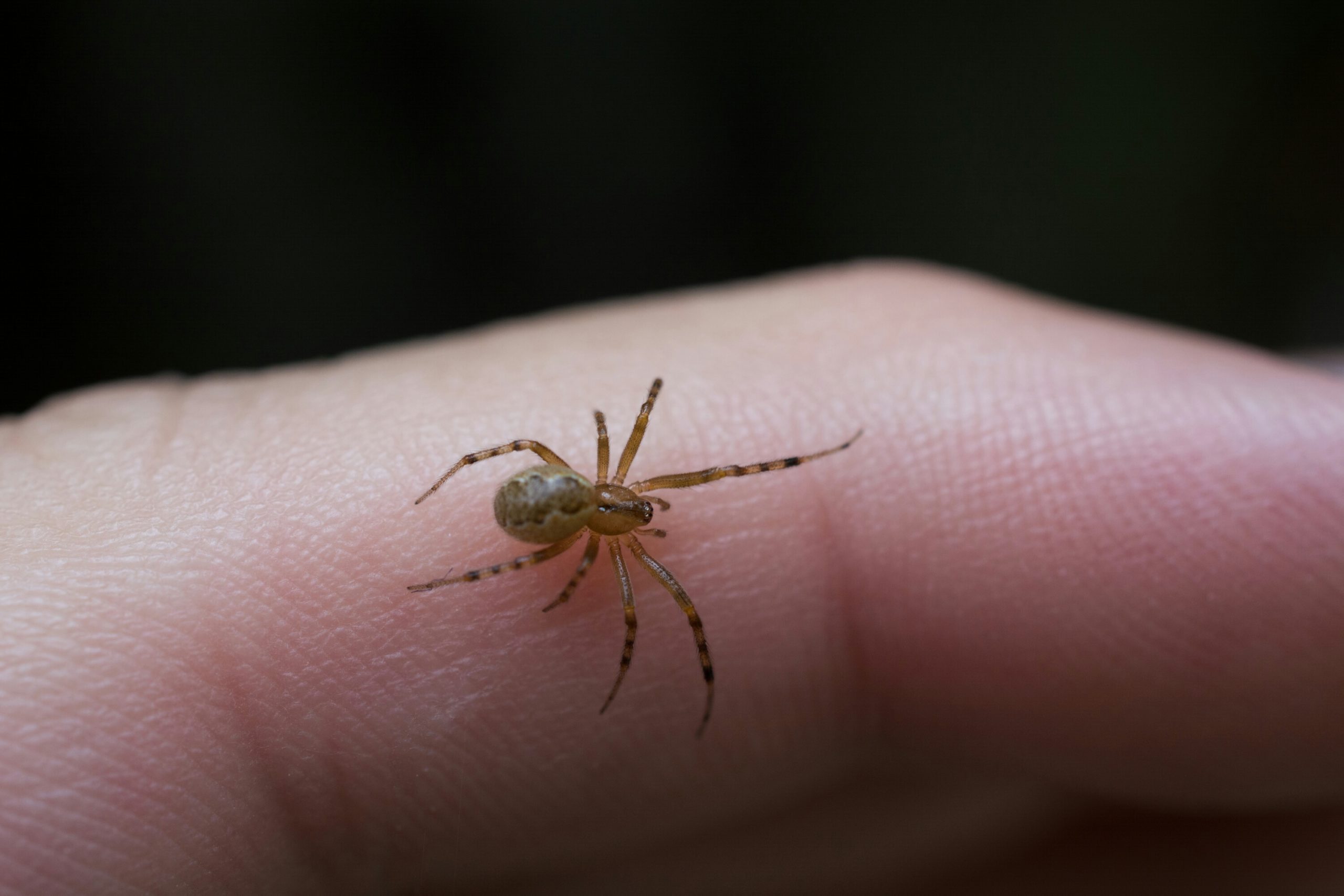
Why do spiders bite?
In a nutshell, it’s self-defense. “In general, spiders will bite only if they can’t get away from you, or are protecting their babies and don’t want to leave the babies behind, and/or they are being crushed or otherwise hurt,” says Sebastian Alejandro Echeverri, PhD, who studies spiders at the University of Pittsburgh. Even the black widow doesn’t bite as often as many people believe. A 2014 study published in Animal Behaviour tested various scenarios to find how often a black widow would bite. Even with continued poking, the black widow spiders either played dead or spit out silk instead of biting. Only one spider out of 43 actually bit the gelatin “fingers,” used for the tests. The biting increased to 60 per cent only when the spider was pinched between two gelatin fingers for an extended period.
Do spiders have dangerous venom?
“Yes, almost all species of spiders have venom, but that venom has evolved to work on animals that the spider eats. And there are no spiders in the world that eat humans,” says Echeverri. Spiders feast on insects such as mosquitoes, flies, moths, beetles and other spiders. Larger spiders might eat lizards and frogs. “Our bodies are so much larger and built so differently than the insects and other animals that spiders do eat, that the vast majority of spiders’ venom just doesn’t work on us,” says Echeverri.
Black widow and brown recluse are venomous
Each individual has his or her own unique response to spider bites. Symptoms may be minor to severe. According to CTV News, the only two spiders native to Canada that are considered venomous, are the black widow and brown recluse. The venom of the black widow contains a neurotoxin that can cause pain at the bite area that spreads to the chest, abdomen, or entire body. However, death occurs in less than one per cent of black widow bites. The brown recluse venom has the potential to destroy skin and cause a severe lesion, for which medical attention may be necessary. Death is rare from a brown recluse bite and reported mainly in children.
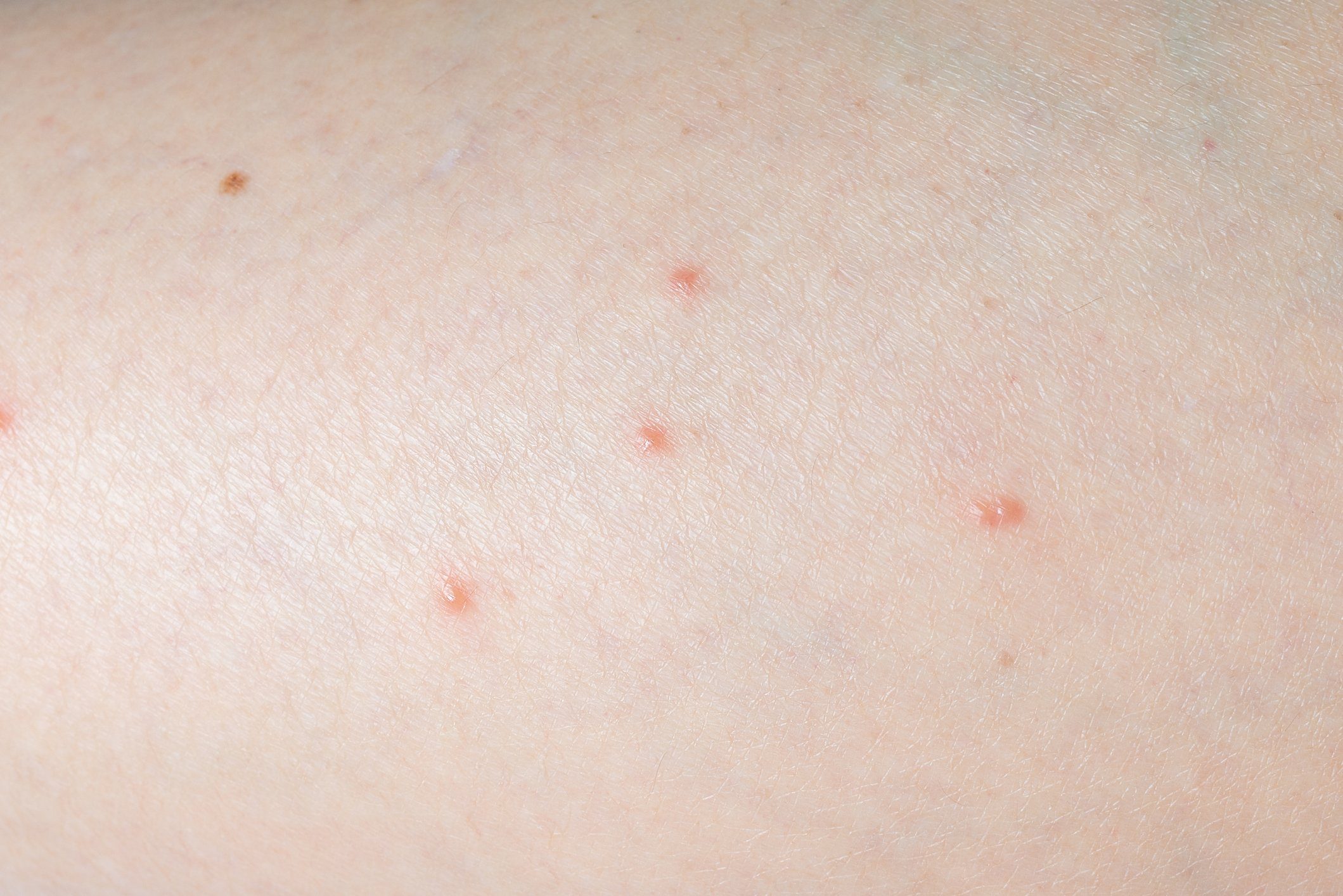
Spider bites
Unless you got a good look at what bit you, it’s difficult to know if the bite came from a spider or an insect—you might even suspect an insect that looks like a spider, such as the jumping spider cricket, which isn’t a spider and doesn’t bite. “Not all skin reactions are bites from an arthropod. You can’t 100 per cent identify what bit you based on a skin lesion. Nor can you diagnose a skin reaction and attribute it to any animal unless you see it biting you or slapped it dead,” says entomologist Jody Green, PhD, at the University of Nebraska, Lincoln. “There are so many other reasons for skin lesions besides spiders,” adds Green. (These skin signs could signal a serious health problem.)
Dermatologist Adam Friedman, MD, professor and interim chair of dermatology at The George Washington University School of Medicine and Health Sciences, says that anything short of the skin-cell death a person gets with a bite like the brown recluse’s will look the same. In other words, you might not be able to say what bit you with confidence, and red bump bug bites are rarely serious and can be treated at home.
Still, medical treatment might be necessary if your symptoms are severe or if you suspect a black widow or brown recluse bit you.
Spider bite symptoms
Remember that from one person to the next, the reaction to a spider bite can be very different. Children, the elderly, pregnant women and those with compromised immune systems might have more severe reactions. The U.S. Centers for Disease Control (CDC) lists possible symptoms of spider bites as:
- Itching or rash
- Pain radiating from the site of the bite
- Muscle pain or cramping
- Reddish to purplish colour or blister
- Increased sweating
- Difficulty breathing
- Headache
- Nausea and vomiting
- Fever
- Chills
- Anxiety or restlessness
- High blood pressure
Also, some individuals may experience anaphylactic shock, an allergic reaction to the venom. Symptoms include rash, hives, intense itching, swelling and redness, sudden swelling of the lips, eyes, tongue, or throat, stomach cramps, trouble breathing or wheezing, or loss of consciousness.
Spider bite treatments
In general, all spider bites are treated the same way, Dr. Friedman says. Here are the steps to treating a spider bite at home:
- Clean the bite with mild soap and warm water
- Apply ointment based moisturizer to damp skin and keep covered with an adhesive bandage if possible
- Take acetaminophen or ibuprofen (so long as not contraindicated) if you have pain
- Apply ice briefly or hydrocortisone one per cent cream if you have itching
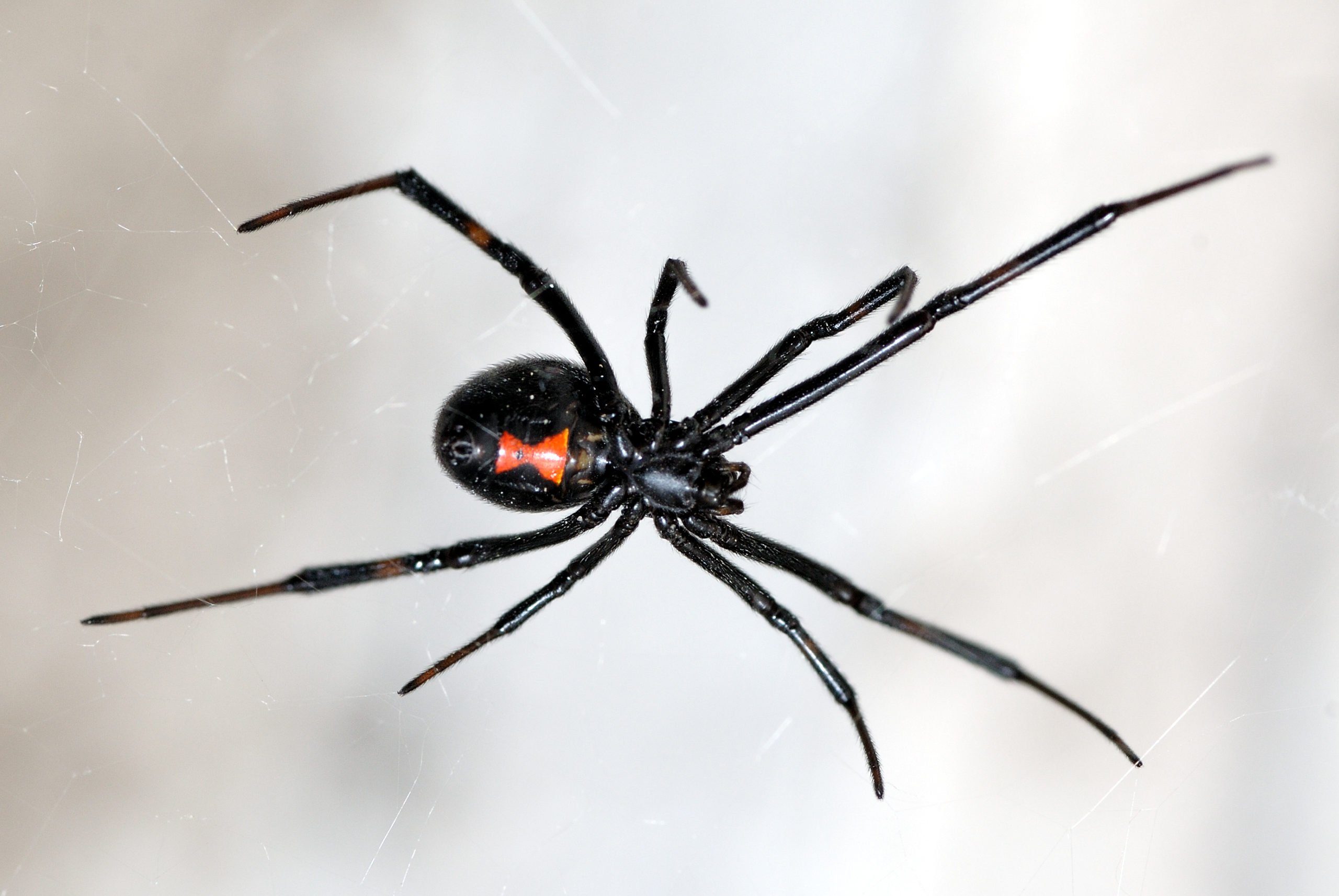
Black widow
As its name implies, this spider is a shiny black colour with a feature unlike any other—a red hourglass marking on the underside of the females’ abdomen. They’re about 2.5 to 4 centimetres (1 to 1.5 inches) in size. Males have light streaks on their abdomen and are smaller. More importantly, it is the larger female that has the bite that’s so infamous. They live primarily in the temperate regions of southern Canada and shun humans if possible. They are content to mind their own business, eating mosquitoes, flies, and other pests we don’t like, all while living quietly outside, close to the ground in garages, rock piles, beneath decks and porches. It’s highly unlikely to see one in your house unless it accidentally hitchhiked in on another object.
Black Widow bite symptoms
You might not even notice when a black widow bites you, or it may just feel like a pinprick—that’s why it’s so challenging to know what bit you. “The bite will appear at first to be a small red bump with surrounding redness and swelling, almost like a hive,” says dermatologist Joesph Zahn, MD, assistant professor of dermatology at the George Washington University Medical Faculty Associates. The initial pain of the bite occurs in just a few minutes and usually subsides within two to three days.” The symptoms may be more severe, depending on how an individual reacts to the venom. In extreme cases, he says, “latrotoxins, a type of neurotoxin in the venom, can cause serious pain and can lead to paralysis.” In addition, sometimes fatal heart damage has been reported, he notes. But he stresses that death due to a black widow spider bite is extremely rare.
Treatment and when to see the doctor
A black widow bite can look like countless other insect and spider bites, but if you suspect you’ve been bitten by one, it’s best to get checked out, Dr. Zahn says. Children, pregnant women, the elderly and those with compromised immune systems should see their doctor or head to the emergency department. If you have fevers, chills, muscle pain, aches, difficulty breathing, or other symptoms that affect your entire body, call your doctor.
Dr. Friedman also suggests a tetanus shot if you haven’t had one in the last decade—tetanus spores can collect inside the bite. Your doctor may recommend prescription medications such as benzodiazepines (a sedative) to help relax your muscles (and you). Antivenin, also known as antivenom, is available for severe symptoms, yet Dr. Zahn adds that it might not work for everyone; it triggers an allergic reaction in some people. A doctor can help you determine your risk based on your health history. In Vetter’s experience, antivenin has been quite effective for extreme pain. “Bite victims including small children go from screaming pain back to normal within 30 minutes,” he says.
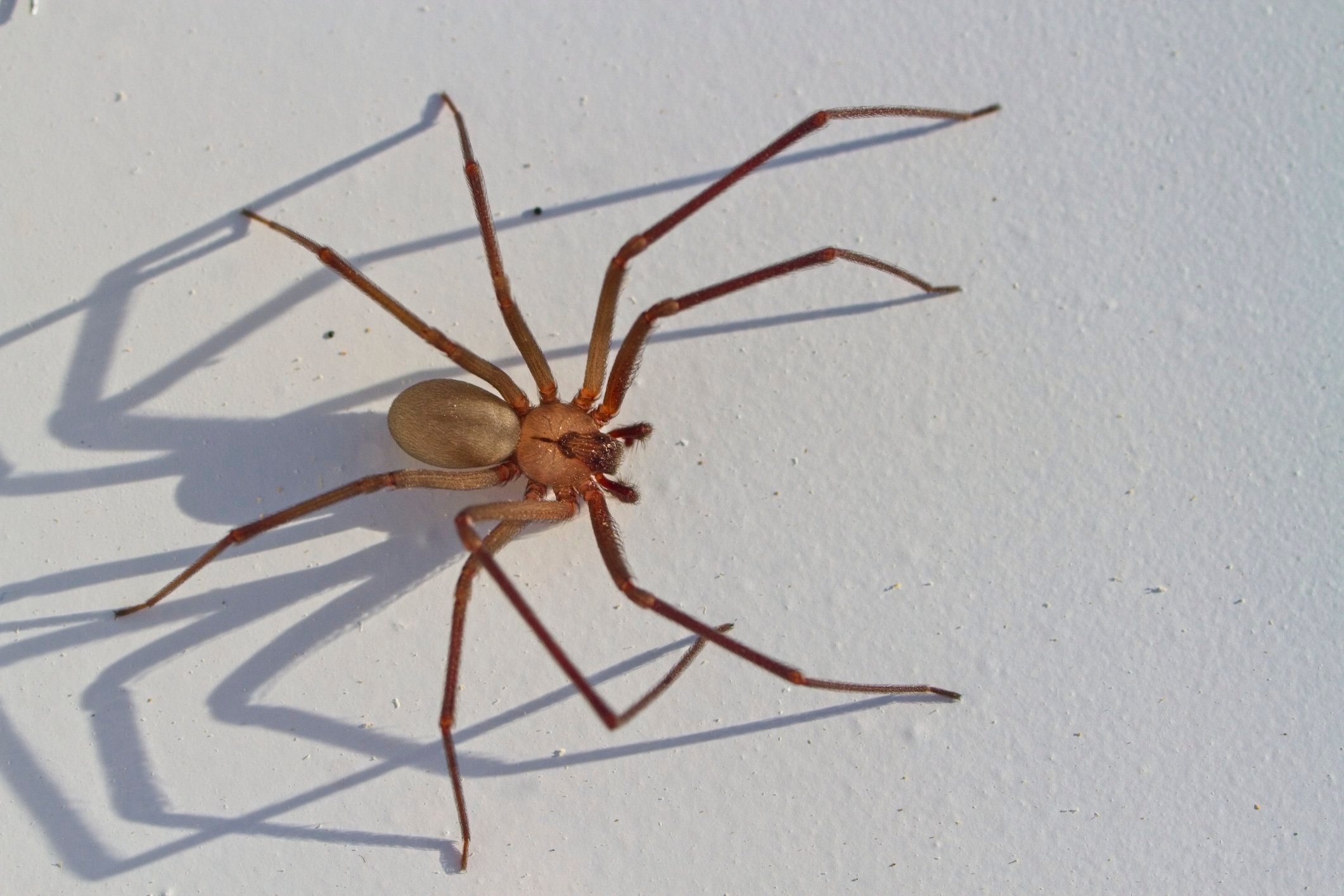
Brown recluse
Also known as the “fiddleback, ” the brown recluse is exceeding rare in Canada, and is identifiable by its dark brown violin-shaped body. And as its name implies, it prefers to live undisturbed, away from humans. Outdoors it lives under rocks, woodpiles, and debris. “They might get in the house, usually by being carried around in storage boxes or in luggage being moved around,” says Green. They hang out in places where they won’t be discovered easily, like in rarely used areas of the basement, attic, or crawl space. “Many, many spiders are misidentified as brown recluse spiders every day,” adds Green. Yet, if you ever got close enough, you would notice a difference from most other spiders. “They are one of the few spiders that have six eyes, whereas most spiders have eight,” says Vetter.
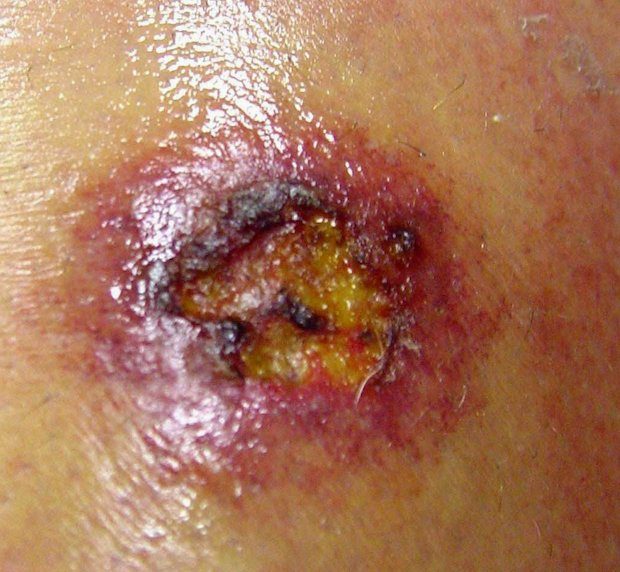
Brown recluse bite symptoms
The good news is most brown recluse bites are mild and self-healing, according to both Vetter and Dr. Friedman. The bite is usually painless— at first. “A painful, severe swollen reaction occurs within the first eight hours,” says Dr. Friedman. Some people may have mild discomfort while others will develop large blisters. “The blisters are surrounded by reddish and white zones. In about a week, the central portion becomes dark and gangrenous,” says Dr. Friedman. That reaction to the bite is known as loxoscelism. Rarely, some people develop systemic loxoscelism, in which the infection at the site spreads through the bloodstream and can be accompanied by nausea, vomiting, fever, and muscle pain In a severe case, Dr. Friedman says it causes a condition called disseminated intravascular coagulation. “This means your blood both clots too much and can’t clot enough at the same time, which is life-threatening.”
Treatment and when to see the doctor
People in the following categories should always seek immediate treatment if they suspect they’ve been bitten by a brown recluse:
- Pregnant
- A child
- Elderly
- Immune-compromised
- A chronic health condition such as diabetes or heart disease
Also, if you feel muscle pain, aches, fevers, chills, difficulty breathing, or other symptoms that affect your whole body, call your doctor. Your doctor might recommend a tetanus shot if you haven’t had a booster in the last 10 years. (These strange symptoms that could signal a serious disease.)
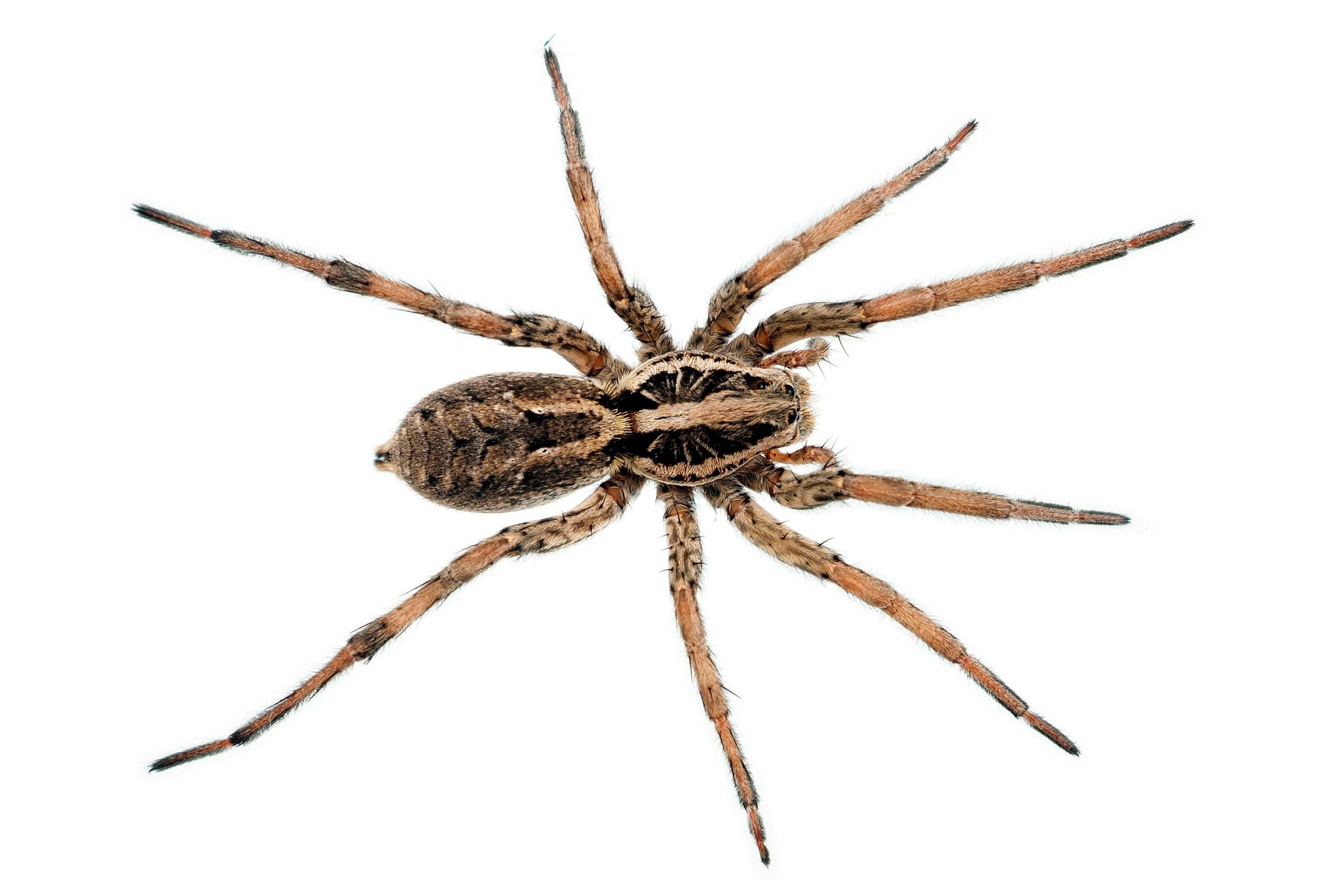
Wolf spider
Wolf spiders are hairy and larger than most common spiders, which might make them seem more creepy and dangerous, but they’re “virtually harmless,” says Vetter. They have a tan to dark brown colour and sometimes sport stripes on their body, paler in colour. Females are about 1.5 centimetres (1.3 inches) long, and males can be up to 5 centimetres (2.5 inches) long. Wolf spiders aren’t web builders. They live across Canada and favour outdoor ground habitats such as woodland leaf litter, stream edges, and they may burrow under flat rocks or fallen tree logs. Inside, depending on where you live, you might see one in your house in the fall near doors, windows, basements, or garages. They’re just looking for a warm place to hang out as temperatures drop outside. (Check out the 10 most disgusting house bugs—and the best ways to get rid of them.)
Wolf spider bite symptoms
As with any spider bite, the severity of any reaction can differ from individual to individual, but typically, wolf spider bites aren’t dangerous. “For the most part, it is localized pain, itching, and minor swelling, a red bump,” says Dr. Zahn. “You might notice the symptoms within a few minutes to a few hours after the bite.”
Treatment and when to see the doctor
“For the most part, these bites rarely pose a risk to your health. If you experience fevers, chills, muscle pain, and aches, or other symptoms throughout your body, call your doctor,” Dr. Zahn says.
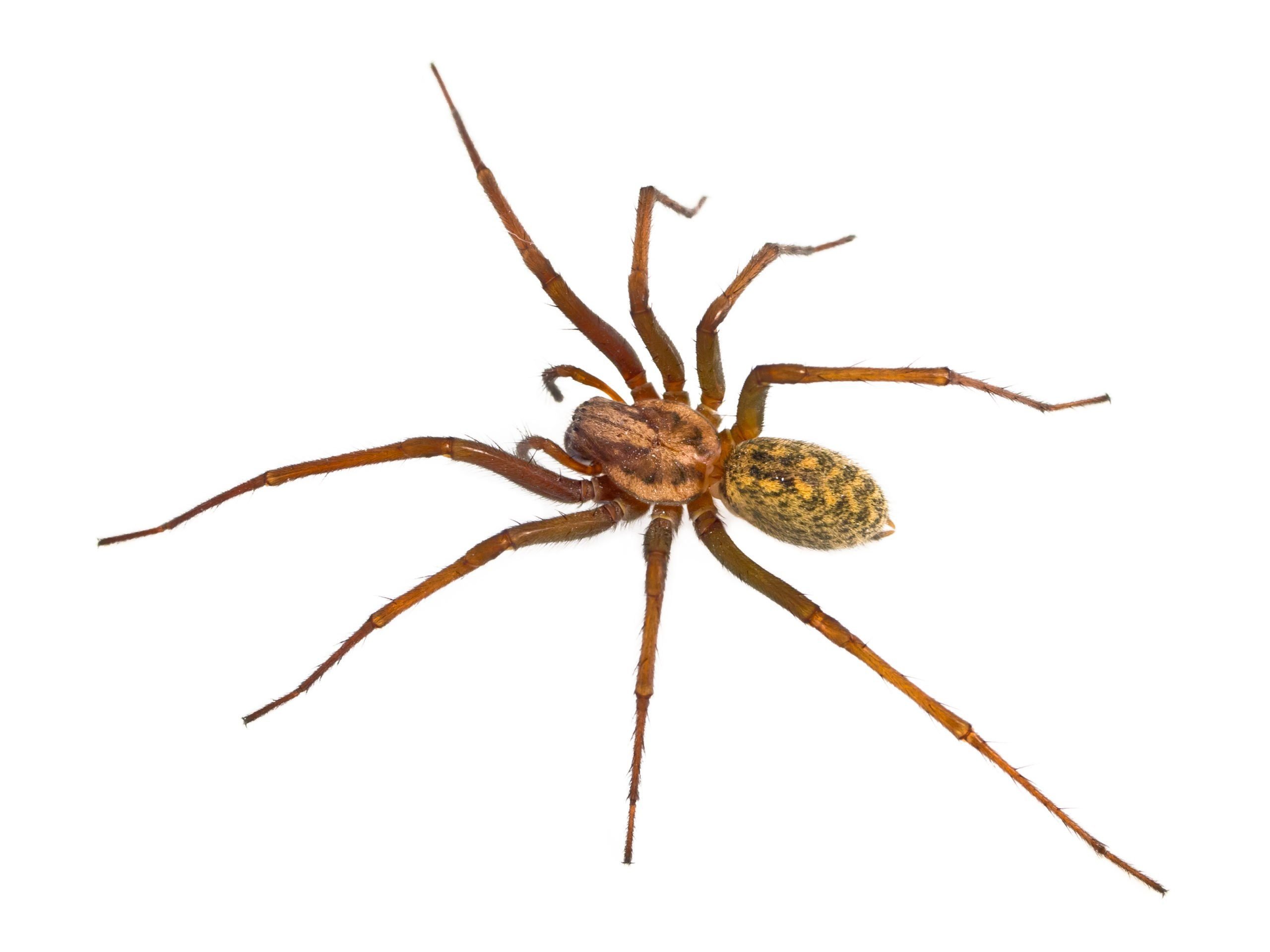
Hobo spider
You would think having eight legs would make getting around a breeze, but the hobo spider, also known as the hitchhiking spider, doesn’t climb up vertical services very well, so it likes to travel on people or other objects to get around. That’s why you might see it running across the floor, more than another type of spider. It’s about 0.5 centimetres (3/16 of an inch) long and typically a shade of brown with dark stripes or other markings, depending on the species. The hobo lives in the Pacific Northwest and favours outdoor living in the standard spider spots: Cracks and holes in woodpiles, under rocks, concrete, and window wells. If they do find themselves inside, they seek out dark and moist areas like a basement or crawl space.
Hobo spider bite symptoms
The bite of a hobo spider is barely noticeable. At most, it may feel like a pinprick. Vetter says the bite is harmless and non-toxic. The CDC removed the hobo spider from its list of venomous spiders in 2017. The bite can result in redness in the area for up to 12 hours. Since the bite is painless, it’s difficult to determine how long it might take to see a reaction, Dr. Friedman adds.
Treatment and when to see the doctor
Follow the spider bite treatment above. It’s unlikely you’ll need to see the doctor, but if you have concerns about the bite area, intense itching, pain, and swelling, call your doctor.
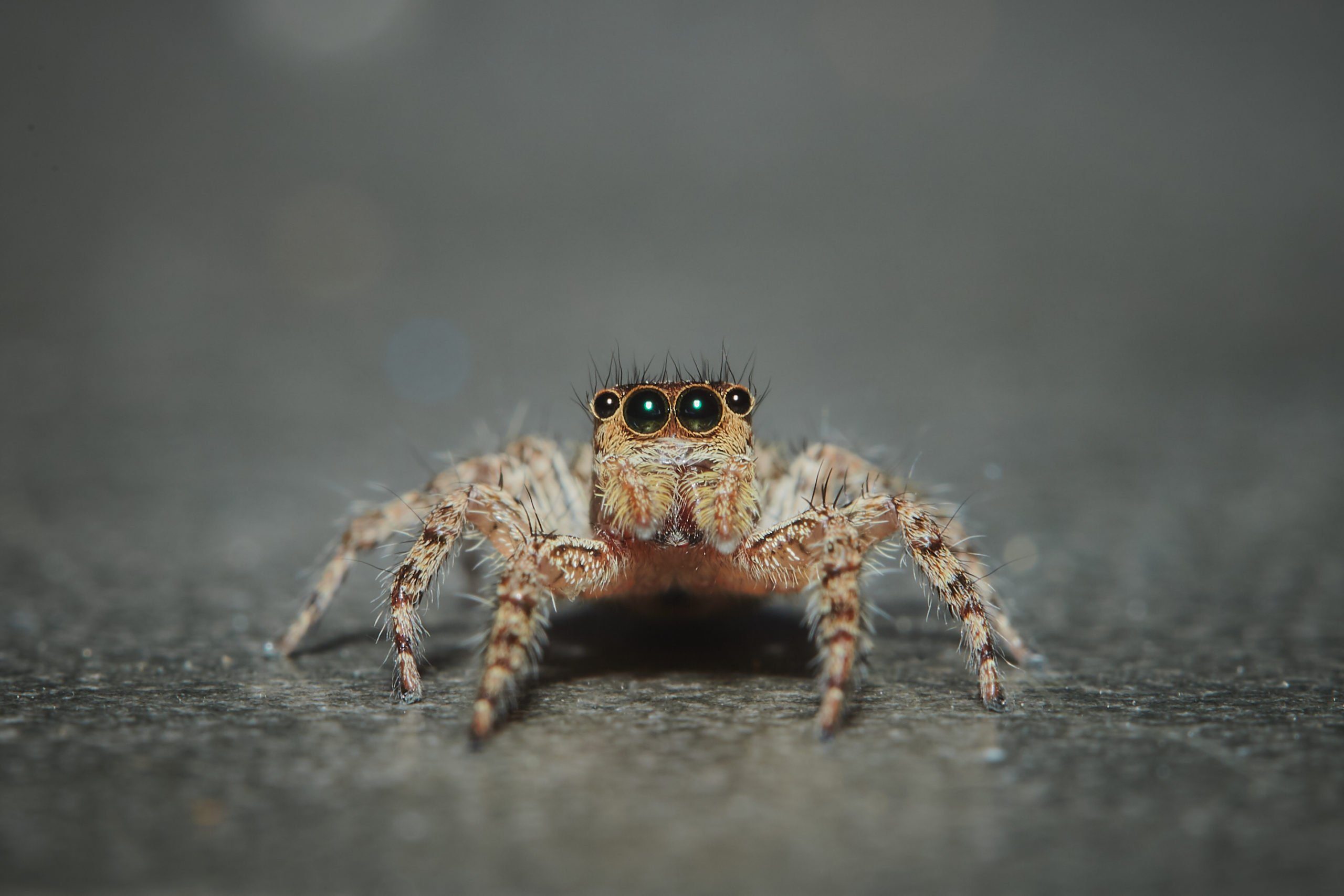
Jumping spider
Found throughout Canada, the jumping spider’s vision is comparable to humans, Vetter says. They have eight eyes in three rows. The front row has four eyes with two larger eyes in the middle. People often mistake jumping spiders for black widow spiders because they both have compact black bodies with relatively short legs. Yet jumping spiders can also be brown, tan, or gray with colourful markings in yellow, red, blue, green, and white. As their name suggests, they jump (and climb) and can be found waiting for their prey (insects) high in tree trunks or low in window wells. They’re far more likely to be outside than inside.
Jumping spider bite symptoms
If a jumping spider chomps you, you’ll see a small bump that is reddish with a bit of swelling. There may be some itching also, depending on how your body reacts to the bite.
Treatment and when to see the doctor
Follow the spider bite treatment guidelines and see your doctor if persistent itching, swelling, or pain persists.
Spider bite prevention
Spiders prefer quiet and out-of-the-way places—a corner in the basement, under storage containers in the garage, or attic. Outside, they favour life under rocks, window wells, nooks, and crannies of the shed, woodpiles, or under the porch. When they sense your presence, they scurry away. Still, avoid an unwelcome encounter and protect yourself by thinking about the areas where spiders might be living that have been relatively undisturbed by human activity, and act accordingly. Wear gloves, long sleeves, and tuck your pants into your socks if you’re working outside. Shake out the boots that have been sitting on the patio. Wash the garden gloves before you put them on. “Watch out for seasonal stuff in the garage like baseball gloves and gardening clothes that sit idle for months. Store them in large zip-closure plastic bags,” Vetter says.
Next, find out the simple hack to keep spiders out of your house.
If you’re ticklish, you know that strange mix of pleasure, surprise, and weirdness when someone finds your ticklish spots. But have you noticed that some people aren’t ticklish? And some people enjoy being tickled and others who find it miserable? Good news: It’s all normal.
“As with any sensory experience, people have different levels of sensitivity to touch and tickle,” says Alicia Walf, PhD, a senior lecturer in cognitive science at Rensselaer Polytechnic Institute in Troy, New York.
And your mood and history with tickling both affect whether you find it delightful or a form of torture. Here’s more about the fascinating science of ticklishness.
What causes a tickle?
Every time you’re tickled, a chain reaction begins involving your brain and your sense of touch. First, it activates “nerve endings in our skin for pain and sensory receptors that are sensitive to light touch and pressure,” Walf says. From there, signals go out to the somatosensory cortex in the brain—that’s the brain region where you identify touch. Through the brain’s limbic structures, such as the anterior cingulate cortex, the brain addresses how it feels, Walf adds. (Think: Does that feel good—or not?)
Next, your brain prompts you to reflexively giggle. “The laughter is processed through the hypothalamus, a conduit between mood and somatic responses,” says Walf. “The cerebellum in the back of the brain exquisitely coordinates all of these responses (and all sensory and movement processes of the brain).”
If you’re one of those people who starts giggling before the other person’s hands are even on you, you probably wonder what’s up with that. It’s about surprise and anticipation—as well as context. “The giggling in anticipation often happens with someone you are comfortable with—not a complete stranger,” Walf says.
Why? The theory is that we’re recalling the pleasant feeling of being tickled by close friends and family in the exact moments before the tickling starts, Walf explains, and that may prompt up to erupt in anticipatory giggling.
You’re more likely to do this pre-giggling if you have happy memories about past tickling with this person and you’re currently in a good mood.
Why can’t you tickle yourself?
To feel that ticklish sensation, there needs to be an element of surprise—and that’s something only another person can supply. In fact, multiple studies, including a report on tickling published in NeuroReport, suggests that we only feel ticklish when someone else is doing it to us because that way our brain—in particular, our cerebellum—can’t predict what sensation is coming next.
Fun fact: There is an evolutionary point to being able to feel and react to a feather barely grazing your foot. “Being very responsive to even slight sensations—especially in places you cannot see and are often particularly ticklish like the bottom of the feet and back of the neck—was adaptive, because these are areas that are important for us to protect from injury,” Walf says. “Even if that injury is the bite of a mosquito on the back of the neck, we feel that slight sensation and reflexively swat the sensation away or try to wriggle away from the source.”
Another theory of tickling is that it is a form of social bonding, just like in animals, and a way to teach children about touch, a PLoS One study suggests. When we tickle our baby’s tummy with kisses or let our preschooler tickle us, we help teach kids which areas of the body are sensitive and what different sensations might be.
Why are only some people ticklish? This is one of the unsolved mysteries of the body. While scientists aren’t sure why some people are much more prone to being ticklish than others, they do know that current mood influences how ticklish a person is at any given time, Walf says.
How you feel about tickling can depend on your mood
Similar to why some people are ticklish and others are not, mood can influence why some people like or dislike it. “How our brains and bodies interpret tickling is dependent on our emotional state,” explains Katie Lear, a child and adolescent therapist in Davidson, North Carolina. “A lot of research suggests that when we are feeling calm and relaxed, our body might interpret tickling as pleasurable, but that’s not the case when someone is angry or stressed.”
Feeling stressed, after all, puts us on high alert, Walf adds. “When we are stressed, we are more attentive and responsive to the information coming through our senses,” tipping the balance from a tickle being a surprising, pleasurable sensation to one that’s unbearable, she explains. (Check out these expert-approved stress management tips.)
Your overall temperament also plays a key role. Are you a giggler in general? Then you may be more susceptible to being ticklish, according to science. In a 1990 study of 100 college students published in Biological Psychology, preliminary findings suggested that people who are prone to smiling and laughing may be more likely to be ticklish.
Another ticklishness study in the journal Cognition & Emotion found that a predisposition to laughter is associated with feeling ticklish.
“We all process sensory information in different ways,” says Lear. “If someone isn’t ticklish or actively dislikes tickling even when calm, that doesn’t mean something is wrong with them—it’s just a personal preference.”

When tickling can trigger anxiety or panic
Loving, consensual touch is powerful and essential to healthy relationships, says Lear. (Find out what happens to your body when you get a hug.) That said, she adds, “touching someone in a way that doesn’t feel comfortable for them has the opposite effect and can erode your relationship over time.”
If your brain has formed a link between tickling and a negative or stressful event (such as being mercilessly teased by an older sibling), being tickled could definitely trigger anxiety or panic. “When you consider that tickling often comes as a surprise, and without clear consent, you can imagine how invasive it might feel to someone who has had previous negative experiences with unwanted tickling or other forms of unwanted touch,” says Lear.
Tickling may be more likely to freak you out early in a relationship when you “haven’t established appropriate trust,” says Lear.
Beyond that, it’s alarming to feel like your boundaries aren’t being respected. “Consent is an issue with tickling, and it’s built right into the game,” says Lear, “how many times have you seen someone saying ‘No, stop it!’ as they’re being tickled, only to have the tickling continue?”
While sometimes these protests are a part of the game and everyone’s in on the joke, that isn’t always the case, she points out. Being repeatedly tickled by your date or partner after you’ve asked them to stop is a “boundary breach and can diminish trust in a relationship,” Lear says.
What do you do if someone keeps tickling you—and you hate it
If the tickling is coming from an innocent place, try having a heart-to-heart. Chat when things are going well, not in the middle of a fight, so your partner is really hearing what you’re saying. Lear recommends focusing on how it makes you feel—not what they did wrong. Her sample script: “I feel really panicked and not in control when you tickle me after I tell you to stop. Please don’t tickle me anymore.”
Keep in mind that your significant other might be tickling as a way to bond as a couple. “Because tickling is such a common bonding experience for parents and children, some people grow up seeing tickling as a way of expressing love and affection,” Lear points out. “Speaking about it in a non-accusatory and even playful way can help your partner empathize with your plight without shaming or otherwise damaging your intimacy.”
Next, find out the scientific explanations behind these quirky body reactions.

IKEA is a mandatory destination for anyone moving into a new home or in need of low-cost napkins and bookshelves. A visit to the Swedish chain usually includes affordable decor, hard-to-pronounce product names, family members of all ages test-driving beds and couches and, of course, Swedish meatballs.
Since the COVID-19 pandemic forced a reimagination of all public spaces, stores like IKEA have implemented changes like physical distancing measures and rigorous sanitization protocols to keep shoppers and staff safe. I recently visited an IKEA in Toronto and noticed a few significant changes: an intimidatingly long line, a lot fewer children and children’s stations, no diners in the restaurant and cart sanitizing stations. Shoppers also seemed to walk quickly through the showroom, instead of meandering and touching everything, as they normally might.
I spoke to Kristin Newbigging, a representative from IKEA Canada, about the brand’s safety measures and changes to the shopping experience. Here are five things that you won’t see at IKEA Canada anymore.

Shortcuts through the showroom
IKEA’s showrooms, where their products are displayed in carefully curated vignettes, were already designed for physical distancing with one-way aisles and tons of signage. “We always had the arrows that you could follow, but we also had a few shortcuts,” says Newbigging. “A lot of those are now blocked off to make sure that we’re able to keep people on that straight-forward journey [through the store].”
Play spaces for kids
To stop the spread of COVID-19 in stores, IKEA has suspended its free in-store childcare service. Småland, the supervised playroom at the entrance of the store where parents could drop their children off while they shopped, is closed for the foreseeable future in order to keep families safe.
Other smaller unsupervised play spaces around the store, which usually featured colouring stations and a variety of toys, have also been removed.

Dine-in restaurant service
Unfortunately for fans of IKEA’s famous Swedish meatballs, most stores in Canada have closed their restaurant. Though there are a couple exceptions (IKEA Coquitlam and IKEA Calgary have reopened their restaurants with new food handling processes and limited capacity), most Canadians will have to wait a bit longer to have in-store mashed potatoes, meatballs and lingonberry jam.
Some IKEA stores have reopened their Bistros for quick take-out orders for items like hot dogs and ice cream. IKEA also sells a variety of food products for customers to take home.
Shortages of plants and home office products
Some of IKEA’s products have become massively popular in the last few months as many of us are now working from home. According to Newbigging, there has been a heightened interest in plants as “people want to really bring the outdoors inside during the extended time at home.” Even before the pandemic, plants were very popular and would often sell out early in the day. In fact, during my recent visit, I couldn’t find any plants (real or fake!) for sale.
Similarly, IKEA’s home office line has seen a boom in interest. From desks to chairs to laptop stands, home office supplies have been in high demand as Canadians transitioned from office life to WFH. Fortunately, none of IKEA’s products have been taken off the shelf permanently and the lack of home office products in stock is only temporary.
Shuttle service
A couple of IKEA’s locations (Etobicoke and North York) have a shuttle service that connects the store to local transit hubs, allowing customers without cars to visit the store. Luckily, I was able to drive to the store as shuttle services have been temporarily suspended at both locations for the safety of customers and co-workers.
Next, find out the ways that a visit to Tim Hortons has changed.
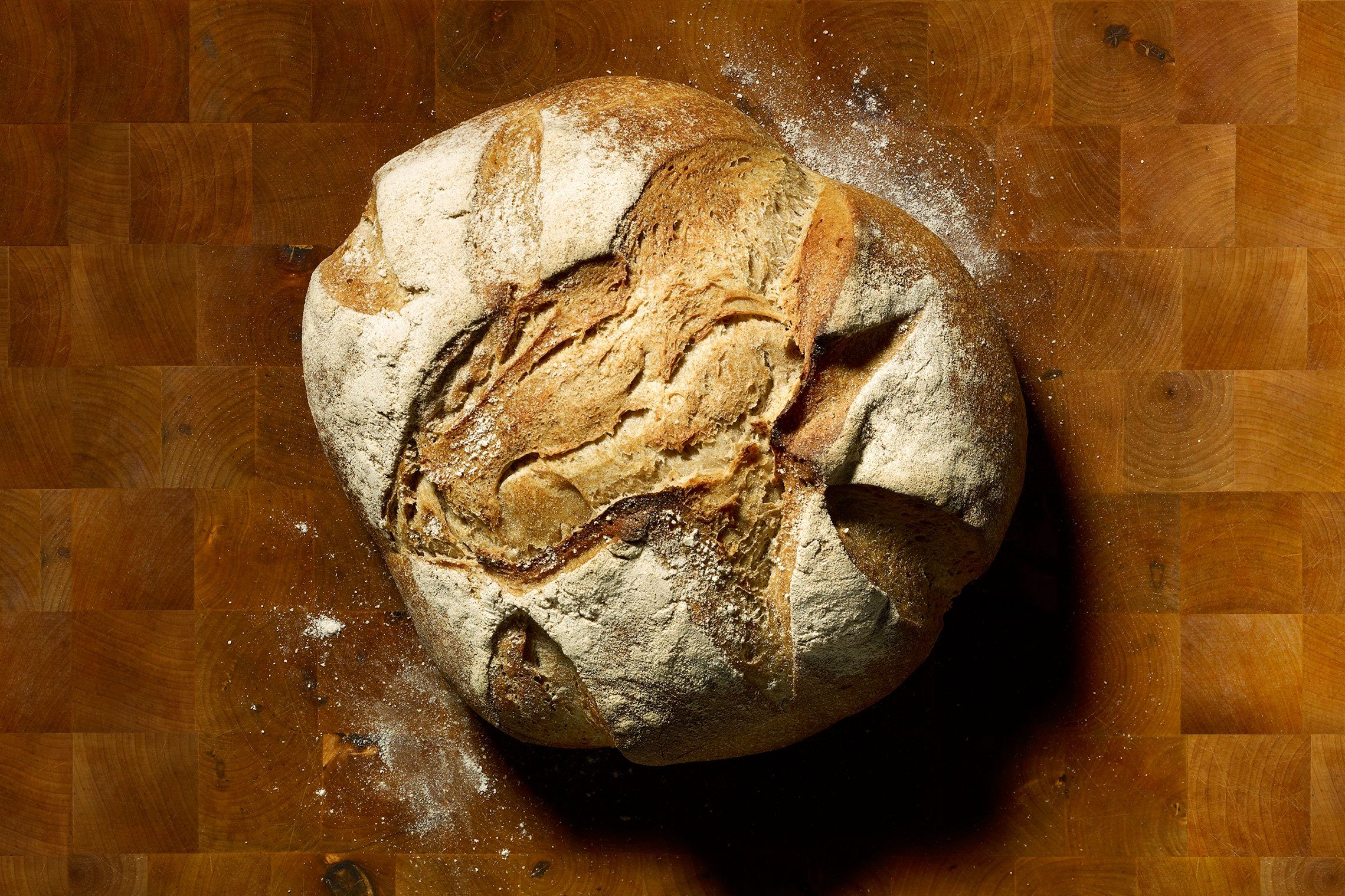
My introduction to baking started with the home-kitchen classic that cracks open the oven door for so many—Nestlé Toll House Chocolate Chip Cookies. It was the 1970s, and most of the moms in our largely Catholic neighbourhood outside of Milwaukee were busy raising big families. For the girls in my house, that meant our mother made sure we knew our way around the kitchen. At the flour-dusted table, Mom taught eight-year-old me how to make the cookies perfectly chewy with a crispy exterior.
We crafted them by the dozen, measuring ingredients from yellow Tupperware containers and mixing everything in my mom’s aqua Butterprint Pyrex bowl, part of a set she’d received as a wedding gift in 1963. Friends who grew up in “fresh fruit is dessert” households could not get enough when they visited. And if they happened to come over when the cookie jar was empty, they were not shy about sharing their disappointment.
So from a young age, I was crystal clear on the power of a baked-to-perfection cookie to make people happy. Baking cookies—then brownies, cakes, and pies—became my hobby and a tasty form of social currency. First I used my skills with butter and sugar to impress a series of teenage boyfriends. In time, the fresh goodies were left on doorsteps to welcome new neighbors and set out in the break room for coworkers. Baking was my superpower.
A few years ago, I became the content director for Taste of Home, the Reader’s Digest sister magazine that celebrates the treasured recipes of home cooks. I’d never been more excited for a new job, but privately I worried that my baking chops wouldn’t measure up. Why? I had a secret as dark as an oven with a burned-out light bulb: While I had baked sweets my whole life, I’d never made a yeast bread from scratch.
Mom couldn’t help me with this one. For her, store-bought frozen dough was her go-to when she needed “from scratch” bread. I understand why: Bread dough provides so many opportunities to fail. Cookies are forgiving. You can be a little off in your measurements, and, trust me, those cookies still disappear from the office break room. Not the case with yeast breads. Most recipes recommend weighing ingredients carefully, down to the gram.
Then there’s the yeast. Yeast is fussy, the Goldilocks of ingredients. Mix it in water too cool and it won’t activate; too hot, and it dies. Yes, yeast is a living, one-celled member of the fungus family. Because it is alive, I could, of course, kill it—and unfortunately rather easily.
And don’t forget that other potential failure point: the kneading. Too little kneading and the bread will be flat. But don’t overdo it! Knead it too much, and the loaf will be tough and chewy.
Still, this was no time for excuses. I was a baker, now one with Taste of Home attached to my name. I may have been intimidated by bread, but it was time. I wanted in.
Getting started, I found Instagram to be a friend. A basic no-knead bread was the one I was seeing online overlaid with dreamy filters. People described it as easy, and to be honest, the thought of removing even one intimidating variable—kneading—was enough to get me to buy five pounds of bread flour and dive in.
I gathered everything I’d need (“be prepared” is the first rule of any baking), including my mom’s trusty Pyrex. It had seen me through my first days as a baker, so I was counting on it to work its magic. I had an easy Taste of Home recipe all set on my iPad. I mixed the flour, salt, and yeast and made sure the water temperature was just right—100 to 115 degrees—before pouring it in.
And then it happened—or didn’t happen. I followed the instructions to the letter, but my dough didn’t rise. Somehow, impossibly, it looked smaller. Sludgy, gooey, wet with a few bubbles. Sad.
The Pyrex bowl didn’t save me, so I had to figure out how to do it myself. Frantically googling “bread dough didn’t rise” yielded a likely answer—the room was too cold. (This is what happens when you live in Wisconsin!) But I found some solutions too. I put the disappointing dough in the oven with the light on, a trick that provides just a bit of gentle heat, to let it try again.
Three hours later, after I’d resisted the urge to keep checking on it like a nervous mom with a newborn, a puffy dough filled the bowl. I hadn’t killed it; it was just… sleeping. A quick fold, a second rise, and then my bread went into my Dutch oven and off to bake.
Thirty minutes later, I took it out. Sure, it was slightly misshapen, but in my eyes, it was golden-brown, crusty perfection, right down to the yeasty-sweet hit of steam coming from its top.
Naturally, the first thing I did was grab my phone and hop on Instagram, positioning my beautiful bread just so in a shining stream of daylight on a wooden cutting board. No one needed to know it was my first yeast bread ever—or how close it came to getting scraped into the garbage can. The online reactions started almost immediately—heart emojis and comments like “This looks DELISH!” from my friends.
They couldn’t taste it, but virtual sharing yields its own rewards.
Finally I cut into that lovely brown crust and doled out slices to my husband and kids. Those slices led to seconds, then thirds, each piece slathered with softened butter and a little sprinkle of kosher salt. I made my family perhaps happier with slices of warm, buttered homemade bread than I had with all the sweets combined. They were used to the cookies and brownies; this was something totally new and equally delicious. Soon enough, I was left with a butter-smeared knife, a few lonely crumbs on the cutting board, and, of course, my post on Instagram as the only evidence of its existence.
At last, I was a bread baker—despite yeast’s best attempts to intimidate me on this first try. No more feeling inferior or afraid. Now I make bread and homemade pizza crust regularly. Yeast and I have such a good relationship that I’m done buying the little packs—I buy it in large enough quantities to fill its own Tupperware container. And I have enough confidence to start thinking (and stressing!) about my next difficult baking challenge: homemade croissants.
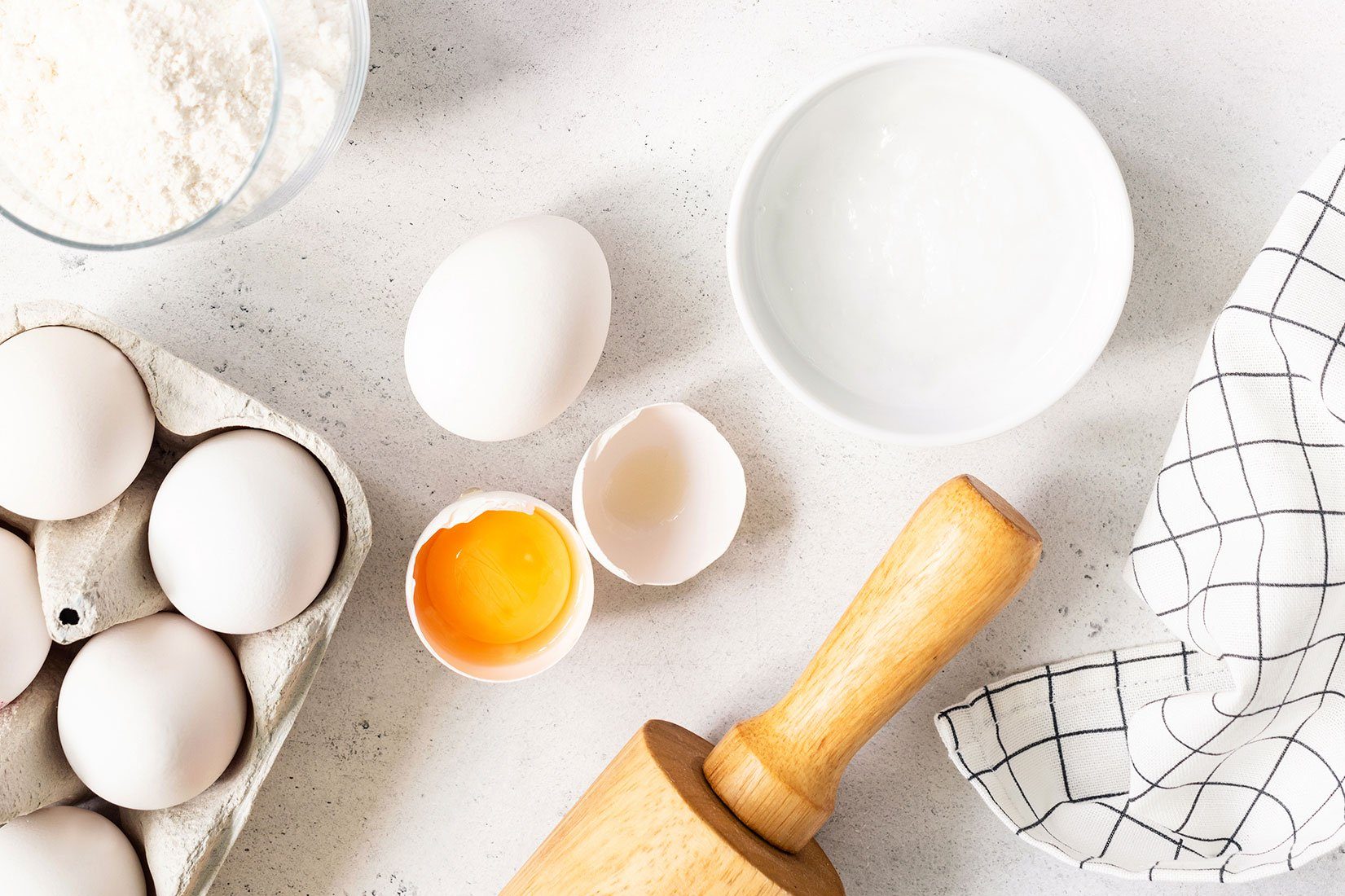
Tips from my trial and error
1. Read the whole recipe before you start.
We’ve all gotten halfway through a recipe only to find we don’t have any buttermilk. Plus, a quick read can help you prepare for what’s ahead, particularly if there are any techniques with which you’re not familiar.
2. Use butter at the right temperature.
Most cake and cookie recipes call for softened butter, which is the right consistency for creaming with sugar. Biscuit and pie pastry recipes call for ice-cold butter in order to create the flakiest layers. If your butter isn’t the correct temperature, your bakes won’t mix up the way they should.
3. Weigh all your ingredients.
When it comes to baking, it’s always preferable to measure your ingredients by weight rather than volume. This ensures you get exactly the right proportions. It may not be critical for something simple like a pan of blondies, but it’s important with fussier baked items, such as macarons.
4. Chill cookie dough.
We know how tempting it is to get your cookies in the oven the second you’re done mixing up your dough. However, chilling the dough can help develop flavours and prevent cookies from spreading too much. Do not skip this step!
5. Coat mix-ins with flour.
When a recipe calls for add-ins (dried fruits, chocolate chips, and/or nuts), you’ll often see instructions to toss them in a bit of flour before adding to the batter. You might think that’s a waste—after all, there’s flour in the batter. But coating these heavy mix-ins helps prevent them from sinking to the bottom of the pan. The extra step gives you even distribution and a prettier result.
6. Cool cakes completely before frosting.
Always let your cakes, cupcakes, and cookies cool completely before frosting them. If they are too warm, the frosting will slide right off the top of your cake or melt and soak in. Cooling racks speed up the process. If you don’t have one, take the cover off your ironing board and use the board as a cooling rack.
Intimidated by homemade bread? Don’t be! These easy bread recipes are perfect for beginners!

Like most businesses this past March, Tim Hortons had to quickly adapt its business. As cases rose and governments issued stay at home orders, Timmies all over the country rapidly shut down their dine-in service, and shifted to drive-through and take-out customers.
Tim Hortons has always been more than a place to grab a quick coffee and donut—it was also a gathering place for communities. “We have folks that gather at our restaurants every day as part of their normal routine, to meet with their family or their friends,” says Tanya Doucette, a restaurant owner in central Alberta and spokesperson for Tim Hortons. “[Before reopening], we had all kinds of folks bringing their lawn chairs from home, and they’d sit in our parking lot or on our lawn and be socially distant from their friends and with their coffees.”
Here are six ways that a visit to your local Tims has changed.
No reusable cups
Before the pandemic, Tim Hortons routinely allowed customers to bring in their own mugs for coffee and tea. In fact, this year’s Roll Up The Rim promotion rewarded reusable cup users with extra entries before the coffee chain suspended the use of reusable cups in stores.
“We suspended our reusable cup service as a temporary measure while we work through this period,” Doucette says “We made that choice as the COVID situation was unrolling around the world.”
Restricted dine-in areas
In parts of Canada where indoor dining is permitted, dine-in areas in Tim Hortons now have fewer tables to limit the number of people there at once. “We have removed tables to create more space around the ones that are left,” explains Doucette. “Guests can come in and they can sit confidently sit with a small group.”

Physical distancing enforced
Customers at Tim Hortons will need to keep the mandatory six feet (or, according to the company, 46 Timbits) between each other while they’re in line and waiting for their orders. “There’s also enough space around [the tables], they have the distance between the pathways where people would walk through the restaurant and also those seated at other tables,” says Doucette.
Heightened sanitation measures
“In the restaurant business, you wash your hands obsessively anyway, but during COVID-19, it’s like every 10 minutes we’re washing our hands,” says Doucette. “There’s a real consciousness around the need to focus on those core procedures.”
Along with extra hand-washing, Tim Hortons has upped their cleanliness game and has focused on extra sanitization of high-touch surfaces like counters, doors, self-serve screens and credit card machines.
Curbside pick-up
At some Tim Hortons locations, curbside pick-up is available for customers who don’t want to go into the restaurant. Customers need to download the Tim Hortons app, place an order and select the curbside pick-up option.
Coffee trucks
In the past, special Tim’s trucks could be found at events like the Calgary Stampede or the Canadian National Exhibition. Now they’re appearing near essential workplaces like hospitals to serve Canadians working on the frontlines of the pandemic. “They’re vans that are dressed up like a Tims,” explains Doucette. “Then inside, it’s like a little mini functioning Tim Horton that serves coffee, tea, iced capps and lemonade.”
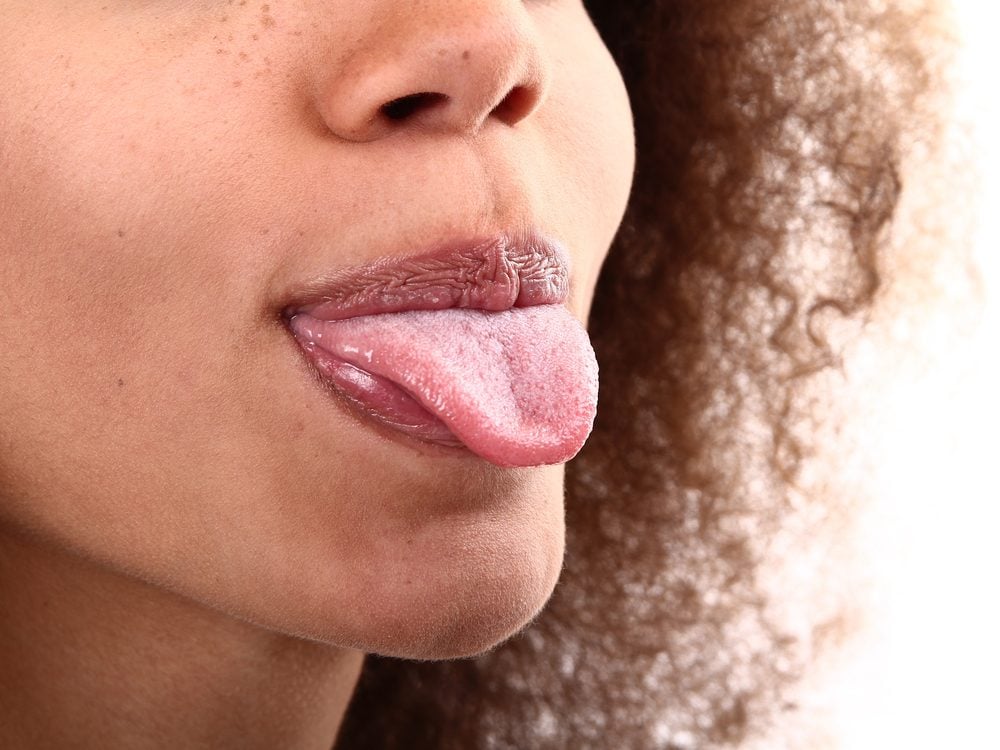
What are bumps on the tongue?
Much like your teeth, hair, skin and nails, your tongue says a lot about your health. Although you might not look at it often, it shows if you need hydration, if you’re missing key vitamins, or if you have any number of diseases. One thing to look out for in particular are bumps on the tongue—they could mean nothing, or that you have an underlying health issue.
The most common tongue bumps are “lie” bumps. Another name for these bumps on the tongue are transient lingual papillitis, which are swollen, small bumps on the tongue or the papillae that exist on the surface, according to Jason Abramowitz, MD, of ENT & Allergy Associates in New York City.
The bumps themselves aren’t dangerous, but they could be because of another health problem. Although the cause is not entirely clear, Dr. Abramowitz says the assumption is inflammation is to blame. It can occur due to viral infections, acid reflux, stress, foods high in acidity, food allergies, or trauma to the tongue, he adds.
Treating these bumps means finding the root cause. Amit Kochhar, MD, clinical assistant professor of otolaryngology and head and neck surgery at Keck School of Medicine of USC, recommends avoiding spicy foods, rinsing with salt water, brushing your teeth after every meal, and using mouthwash to reduce mouth bacteria. “Most cases of tongue bumps should last two to three days,” says Dr. Kochhar.
There are a whole host of other reasons
Bumps on the tongue come in many other varieties. Tongue fissures, shallow or deep grooves on the surface of the tongue, are usually bumpy and trap food, according to Omid Mehdizadeh, MD, an otolaryngologist and laryngologist at Providence Saint John’s Health Center in Santa Monica, California. They are associated with Sjogren’s syndrome, an autoimmune disorder that also causes dry eyes and dry mouth, as well as Down syndrome, and tongue inflammation, too. These grooves or bumps on the tongue are harmless, but oral hygiene is crucial if you have fissures. Cleaning the tongue prevents irritation and possibly bad breath from lingering foods, according to AAOM.
People with white patches or plaque-like spots or bumps on the tongue might be dealing with leukoplakia. Dr. Mehdizadeh says this often occurs in people who smoke, dip, or chew tobacco as it irritates the tongue. If you think you have leukoplakia, Dr. Mehdizadeh says treatment might include a biopsy to rule out cancer. Similarly, squamous cell carcinoma are thick white or red lesions that might be painful and are associated with alcohol and tobacco use, too, according to Dr. Mehdizadeh.
Still, other possible reasons for various tongue bumps include everything from Epstein-Barr virus (EBV) and herpes, to human papillomavirus (HPV). People with EBV could have oral hair leukoplakia, white, sometimes hairy, patches on the tongue; people with HPV could have papilloma bumps; and people with herpes develop cold sore blisters on the tongue, gums, or mouth.
The worst case scenario…
Although rare, bumps on the tongue could be a sign of oral cancer. Cancers of the tongue often begin as raised white patches that don’t hurt, Dr. Abramowitz says. Fully-formed cancerous lumps or bumps on the tongue often look like an ulcer, are pink or red-ish, and bleed easily. Any lesion that is persistent, painful, firm, bleeding, or growing, should be evaluated by your doctor, Dr. Mehdizadeh says. It’s never a bad idea to bring up any physical changes with your doctor.
If you see these 12 things on your body, call your doctor.

Will taking your car through an automatic car wash damage the finish? Sadly, the answer is yes. While some types of carwashes are worse than others, any time you wash your car—even if you are carefully hand washing it—you are essentially applying an abrasive and/or harsh chemicals to the paint finish, and the risk of swirls and scratches in the finish is always there. That’s the bad news. The good news is that if you make careful choices you can minimize the degradation of your paint’s appearance. Plus, most modern car finishes applied at the factory include a topcoating that is very durable and should hold up for at least 10 years.
Tunnel car washes with rotating brushes
The “traditional” old-style car wash with rotating bristle brushes is much maligned in favour of other, newer car wash technologies that are described as gentler to your car’s finish. But head-to-head comparisons have shown that the old-school car washes will actually cause less damage to your car’s finish than the newer alternatives because the brushes do not hold onto abrasives (like grit) to the extent that soft cloth scrubbers do.
Soft-cloth car washes
Some car washes that are not “touchless” feature flaps of cloth that massage your car clean and seem less aggressive. But they do retain the abrasives from every car that has preceded yours, more than brushes do. And, latent abrasives in the scrubbers are the primary offenders when it comes to car finish damage. (Learn how to fix paint chips on your car.)
Touchless car washes
Car washes that use the “laser wash” approach do not have the abrasive effect on your paint finish that car washes making direct contact with the vehicle do. But, there is a trade-off. They do not get your car as clean, as a little scrubbing is necessary to dislodge some of the grit and grime. And, they use more caustic detergents to compensate for the lack of direct contact. A touchless car wash is okay once in a while, but regular exposure to these chemicals will degrade the finish. (Find out why you need a clay bar in your car care arsenal.)
Hand washing
Most auto detailers who pursue the perfect car finish insist that only hand-washing will get you there. But even with hand-washing there are risks. Using the same sponge to clean the vehicle’s painted surfaces and the tires and wheel wells is a common mistake that introduces abrasives into the cleaning process. Take care to segregate your sponges and rinse and clean them, as well as your microfibre towels, religiously.
Here are a few tips for safe and effective automatic car wash use:
- If you are waiting in line at a car wash and the vehicle in front of you looks like it is fresh from a week of off-roading in the mud, give up your place in line and come back another time. Car washes of all types “self-clean,” but not that fast. It takes a few cycles of rinsing to rid the brushes or soft cloth of excessive grit that can damage your finish.
- Evaluate the facility. If it’s clean and modern on the outside the chances are good that they take care of the washing parts, too.
- Most of the “extras” are probably not worth paying for. A spray-on “wax” will give a nice sheen but will fade in a few days. Do select the undercarriage cleaning, but only a couple of times a year.
If your goal is to keep your car in mint condition, avoid these driving and maintenance mistakes at all costs.

The last words of Steve Jobs
People know Steve Jobs for his creativity, innovation and inspiring quotes. So there was a lot of hype and curiosity regarding the late Apple co-founder’s last words. In 2015, rumours were circulating online that his last words were in an essay warning how the “non-stop pursuit of wealth will only turn a person into a twisted being.”
The essay also boasts the importance of treasuring life and family before material things or success. “The wealth I have won in my life I cannot bring with me,” the essay reads. “What I can bring is only the memories precipitated by love.” Although some might argue that these points are important, there is no evidence that Jobs is the author of the essay. According to Snopes, the essay only appears on unofficial social media accounts, blogs, and neither the Jobs family nor Apple confirmed its legitimacy.
That said, his sister Mona Simpson briefly mentions his last words in her eulogy published in the New York Times. “Steve’s final words, hours earlier, were monosyllables, repeated three times,” she said. “Steve’s final words were ‘OH WOW. OH WOW. OH WOW.'” The eulogy notes that Jobs repeated this phrase after looking at his sister, Patty, his children, and his life partner, Laurene. The New York Post also reports that Jobs had some harsh words for his daughter, Lisa Brennan, on his deathbed. In a tell-all memoir about her relationship with her father, Brennan says Jobs told her she “smelled like a toilet” during one of their last visits, according to the Post.
Even though no one will ever know the exact meaning of his final words, people will likely continue speculating their purpose, indefinitely.
Next, discover more last words from history’s most iconic people.






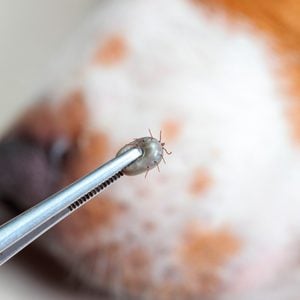
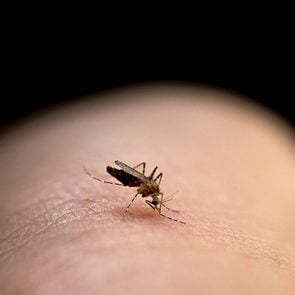


 How These 10 Body Parts Got Their Names" width="295" height="295" />
How These 10 Body Parts Got Their Names" width="295" height="295" />






